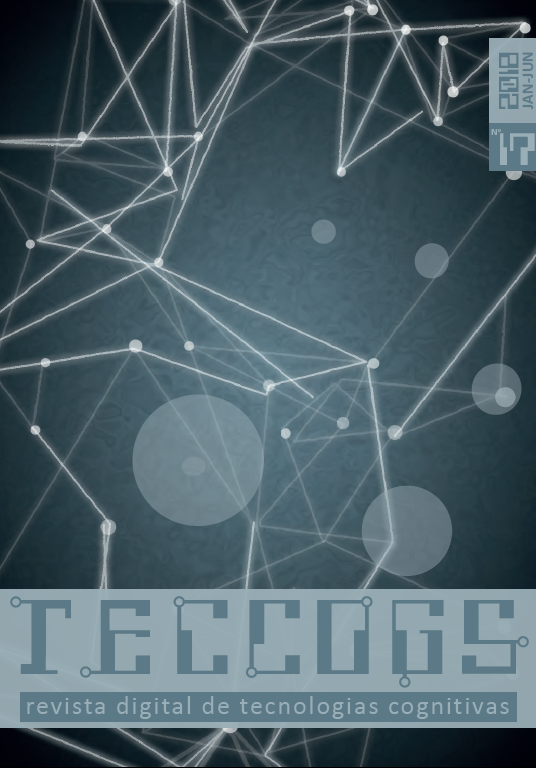Can a machine wish?
DOI:
https://doi.org/10.23925/1984-3585.2018i17p128-144Keywords:
Artificial Intelligence, Desire, Pattern recognition, Natural language ProcessingAbstract
The paper presents an the analysis of Turing’s classical question “Can
machines think?”. It extends this question to the one of: “Can a machine wish?”. The purpose is to provide different perspective concerning Artificial Intelligence, which began with Turing’s article Computing machinery and intelligence, published in 1950. Considering the relationship between thoughts and desires, the study examines the meaning of the concepts of “machine” and “to think” in the context of Artificial Intelligence. Turing’s article is the point of departure. The paper advances toward an interdisciplinary approach to the humanities and computer sciences, including authors such as Descartes, Lacan and Christopher Bishop. The findings of this study suggest that the concept of “machine” used by Alan Turing, is losing its meaning with the advance of Artificial Intelligence toward “artificial entities” that can become our image and likeness. Such entities will be able to not only think, but also to have desires.
References
BISHOP, Christopher. Pattern recognition and machine learning. New York, NY: Springer, 2006.
DESCARTES, René. O discurso do método. São Paulo: Martins Fontes, 2009.
DESCARTES, René. As paixões da alma: grandes obras do pensamento universal. São Paulo: Lafonte, 2017.
GUIMARÃES, Maria. Uma ferramenta para editar o DNA. Pesquisa Fapesp, v. 240, p. 38–41, 2016.
HELLER, Agnes. O quotidiano e a história. Rio de Janeiro: Paz e Terra, 2008.
LACAN, J. A instância da letra no inconsciente ou a razão desde Freud. In: Escritos. Rio de Janeiro: Jorge Zahar, p. 493-533, 1998.
LACAN, J. Função e campo da fala e da linguagem em psicanálise. In: Escritos. Rio de Janeiro: Jorge Zahar, p. 237-324, 1998.
LACAN, J. Simbólico, imaginário e real. In: Os nomes do pai. Jorge Zahar, Rio de Janeiro: Zahar, p. 9-54, 2009(1956).
LATOUR, Bruno. On recalling ANT. In: LAW, John, HASSARD John. (Org.). Actor-network and after. Oxford: Blackwell, p. 15-26, 1999.
MEUNIER, Jean Guy. Artificial intelligence and the theory of signs. Semiotica, vol. 77, p. 43-63,1989.
MURTA, Claudia; FALABRETTI, Eric. O autômato: Entre o corpo máquina e o corpo próprio. Natureza humana, v. 17, nº. 2, p. 75-92, 2015.
PRIMO, Alex. Interação mediada por computador: comunicação, cibercultura, cognição. Porto Alegre: Sulina, 2007.
SAAD CORRÊA, Elizabeth; BERTOCCHI, Daniela. A cena cibercultural do jornalismo contemporâneo: web semântica, algoritmos, aplicativos e curadoria. Matrizes, v. 5, p. 123-144, 2012.
TURING, Alan. Computing machinery and intelligence. Mind. New Series, vol. 59, no. 236, p. 433-460, Oct. 1950.
Downloads
Published
How to Cite
Issue
Section
License
Copyright (c) 2018 Midierson Maia

This work is licensed under a Creative Commons Attribution 4.0 International License.
Esta revista oferece acesso livre imediato ao seu conteúdo de acordo com a licença CC BY 4.0, em conformidade com a definição de acesso público do Directory of Open Access Journals (DOAJ).
Ao submeter um texto à TECCOGS, os autores asseguram que o material submetido à avaliação e eventual publicação não infringe de modo algum qualquer direito proprietário ou copyright de outros. Com a submissão, o autor transfere em efetivo os direitos de publicação do artigo para a TECCOGS. A transferência de copyright cobre os direitos exclusivos de publicação e distribuição do artigo, incluindo reimpressões ou quaisquer outras reproduções de natureza similar, além de traduções. Os autores mantém o direito de usar todo ou partes deste texto em trabalhos futuros de sua autoria e de conceder ou recusar a permissão a terceiros para republicar todo ou partes do texto ou de suas traduções. Para republicar números da revista na íntegra, qualquer interessado precisa obter permissão por escrito tanto dos autores como também dos editores da TECCOGS. A TECCOGS por si só pode conceder direitos relativos a emissões de periódicos como um todo.
Imagens com direitos autorais pertencentes a terceiros, que não foram concedidos ao autor do texto, devem ser utilizadas somente quando necessárias à análise e ao argumento da pesquisa, sempre indicando as respectivas fontes e autoria. A TECCOGS dispensa o uso de imagens meramente ilustrativas. Se desejar ilustrar um conceito, o autor deve indicar, em forma de URL ou referência bibliográfica, uma referência em que a ilustração esteja disponível.
---------------------------------------------------------------------------------
This journal offers free immediate access to its content under CC BY 4.0, in accordance with Directory of Open Access Journals' (DOAJ) definition of Open Acess.
When submitting a text to TECCOGS, authors ensure that the material submitted for evaluation and eventual publication does not infringe any proprietary right or copyright. Upon submission, authors effectively transfer the publication rights of the article to TECCOGS. The copyright transfer covers the exclusive rights of publication and distribution of the article, including reprints or any other reproduction of similar nature, in addition to translations. Authors retain the right to use all or parts of the text in future works of their own, as well as to grant or refuse permission to third parties to republish all or parts of the text or its translations. In order to fully republish issues of the magazine, anyone interested must obtain written permission from both the authors and the editors of TECCOGS. TECCOGS alone can grant rights relating to issues of journals as a whole.
Images whose copyright belongs to third parties that have not been granted to the author of the text should be used only when essential for the analysis and argument, always indicating theirs respective sources and authorship. TECCOGS dismisses any use of merely illustrative images. To illustrate a concept, the author must indicate, in the form of a URL or bibliographic reference, a source in which the illustration is available.


